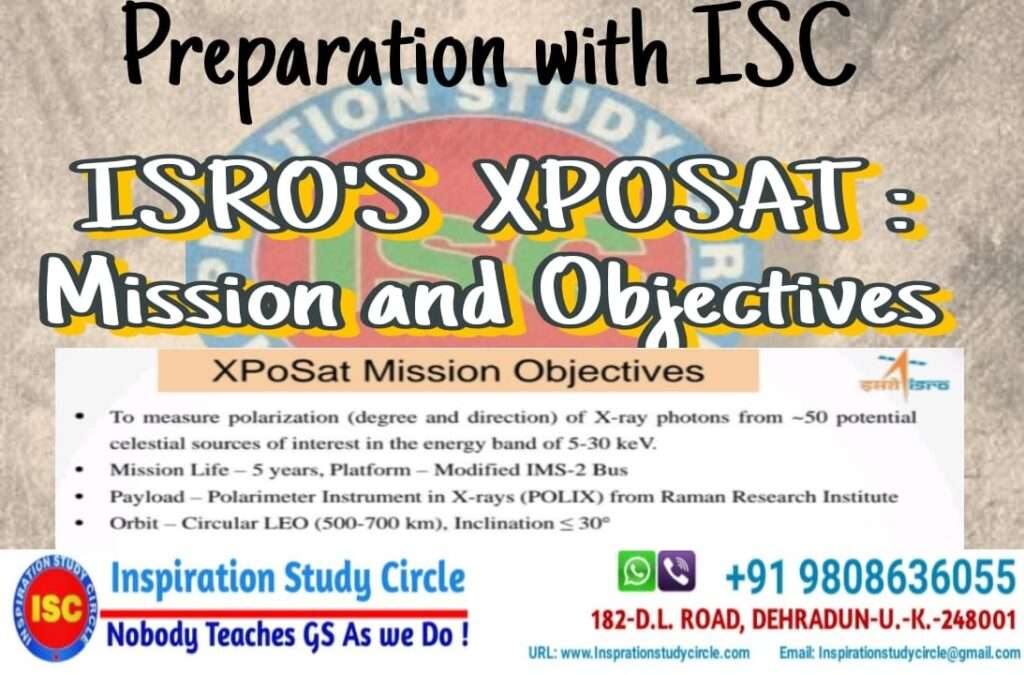
The Viksit Bharat – Guarantee for Rozgar and Ajeevika Mission (Gramin) Bill, 2025
The Viksit Bharat – Guarantee for Rozgar and Ajeevika Mission (Gramin) Bill, 2025 Table of Contents The Viksit Bharat – Guarantee
XPoSat is the world’s second satellite-based mission dedicated to X-ray polarimetry measurements. It is a crucial topic for current affairs and Science & Technology for candidates preparing for UPSC Prelims 2024, and UPPCS 2024. Here’s everything you need to know about the mission.
The Indian Space Research Organization (ISRO) launched its first polarimetry mission, the X-ray Polarimeter Satellite (XPoSat), after a 21-minute flight on Monday (January 1) morning into a 650 km circular orbit.
The X-ray Polarimeter Satellite (XPoSat) is a space observatory launched by the Indian Space Research Organization (ISRO) to study cosmic X-ray polarization. It was launched on January 1, 2024, on a PSLV rocket and has a life expectancy of at least five years.
The telescope was developed closely with the Raman Research Institute (RRI) and UR Rao Satellite Center (URSC). According to ISRO, this mission complements NASA’s efforts to launch the Imaging X-ray Polarimetry Explorer (IXPE) in 2021 to observe space phenomena in a wide energy range of 2-30 keV.

The Indian Space Research Organization (ISRO) launched its first polarimetry mission, the X-ray Polarimeter Satellite (XPoSat), after a 21-minute flight on Monday (January 1) morning into a 650 km circular orbit.
The X-ray Polarimeter Satellite (XPoSat) is India’s first mission to analyze the polarization of X-rays emitted by bright sky sources in the medium frequency band. XPoSat consists of two payloads, including the Indian X-ray Polarimeter (POLIX) and X-ray Spectroscopy and Timing (XSPECT). They are built by Raman Research Institute and UR Rao Satellite Centre, both located in Bengaluru.
The spacecraft is designed to observe from low Earth orbit (50,650 km, low inclination ~6 degrees). It has a lifespan of about five years, during which XPoSat will observe sources that emit polarized X-rays. Observations will be made when a magnetic or neutron star (highly magnetic and exhibits a wide range of X-ray activity) passes through the Earth’s shadow, for example during an eclipse.
Learn how polarized radiation provides information about the nature of its source, including the strength and distribution of the magnetic field and other radiation properties around it. XPoSat will study 50 of the brightest sources in the universe, including pulsars, X-ray black hole binaries, active galactic nuclei, neutron stars, and non-thermal supernova remnants. The observatory is placed in a circular low Earth orbit of 500–700 km (310–430 mi). Payloads on XPoSat will see X-ray sources during an Earth eclipse.
XPoSAT was successfully launched aboard PSLV-C58 on January 1, 2024, at 9:10 AM. The flight was accurate, only missing (±) 3 km. After launch, the final stage of PSLV 4 was placed into a 350 x 350 km orbit to facilitate its use as the PSLV Orbital Experiment Module POEM-3.
XpoSAT can benefit from equatorial conditions at India’s Satish Dhawan Space Center spaceport to fly the PSLV. ISRO was successful in orbiting XPoSAT in High orbit and had done it in PSLV-DL, ISRO’s most sought-after vehicle, with only two straps on PSOM-XL.
The XPoSat payload resides on a modified IMS-2 satellite bus. The main scientific payload is the Polarimeter Instrument in X-rays (POLIX), which will study the degrees and angles of polarization of about 50 types of bright astronomical X-ray sources while operating in the energy range of 8-30 keV. POLIX, a 125 kg (276 lb) device, was developed by the Raman Research Institute.
POLIX is the primary science payload on XPoSat. Thomson X-ray polarimeter that measures the degree of polarization (polarimetric parameter) of astronomical sources in medium X-rays (8-30 keV). It is developed by the Raman Research Institute.
It is the first instrument designed to operate in the mid-8-30 electron kilovolt (keV) X-ray energy band. It contains a collimator, which is the main component to filter the light coming from the light source in the field of view. In addition, there is a scatterer (to prevent the escape of trapped light) from four X-ray counter detectors. Several dozen astronomical sources will be observed.
The test configuration consists of four X-ray proportional counters as X-ray detectors that collect scattered X-ray photons, with xenon envelope collimators, and low-Z scattering (Lithium, Lithium Hydride, or Beryllium). The device rotates along an axis that measures the distribution of scattered X-ray photons, which provides polarization information. Polarized X-rays will produce an azimuthal modulation in the count rate, in contrast to the uniform azimuthal distribution of the unpolarized X-ray count rate. POLIX has four independent detectors, each with its own front end and processing electronics. Localization in X-ray photon detectors is accomplished by separating charges in a series of resistive anode wires connected in series.
The main objects to be observed by this instrument are X-ray accretion neutron stars, rotating pulsars, magnetars, and active galactic nuclei that form black holes in various spectral states.
XSPECT is a secondary payload on XPoSat. Spectroscopic data measure the timing of soft X-rays and electromagnetic spectra produced by various substances. XSPECT is designed for temporary studies of soft X-rays (0.8-15 keV), complementing the work of the Large Area X-ray Proportional Counter (LAXPC) on AstroSat at higher energies, while providing sufficient spectral resolution in the 1. 20 keV band. It has an energy resolution of 5.9 keV (-20 °C) and a time resolution of ~2 msec. Developed by Space Astronomy Group, URSC.
The detector uses Swept Charge Devices (SCD), a type of X-ray charge-coupled device (KCD), to reach low-emission regions without using focusing optics. SCDs provide reasonably good spectral resolution due to their fast readout (10–100 kHz) and positional sensitivity. These devices require very good cooling requirements unlike conventional X-ray KCDs (only requiring passive cooling).
The main science goals of XSPECT include understanding the long-term behavior of X-ray sources by correlating time characteristics with spectral position changes and emission line changes.
XPoSat will be a game changer and will facilitate possible X-ray polarization measurements from bright sources in the mid-energy range (8-30 keV) – never before attempted.
The XPoSat team identified several dozen sources emitting X-rays. XPoSat will observe two types of sources – persistent sources (targets and known sources) and transient sources (pulsars, active galactic nuclei, magnetars).
In space, X-rays become polarized for several reasons. For example, X-rays when exposed to a strong magnetic field or due to interaction with the material around the black hole. Thus, by studying polarized X-rays emitted by supermassive sources such as magnetars, black holes and their surroundings, and neutron stars, scientists can investigate the nature of the radiation and the many processes involved in its production.
POLIX will make important measurements such as the degree and angle of polarization of X-ray photons from the medium around black holes, neutron stars, and other cosmic bodies. These two additional parameters, along with spectrographic, timing, and imaging data, will help researchers generalize the current understanding of celestial bodies and ultimately unlock the unknown mysteries of the universe.
X-rays are made up of continuous electric and magnetic waves. Because they are sinusoidal waves, they do not follow a patterned direction of motion. Polarized X-rays are both ordinary and have two waves oscillating in the same direction. When a magnet or a black hole emits X-rays, they find various materials in the universe. When X-rays pass through a cloud of thick material, the electrical component of the X-rays emits photons in a changed direction because the current is scattered. In this process, the new photon is polarized in the direction perpendicular to the plane formed between the original and the scattered photon.
Measurement of the polarization – the angle and degree of polarization – of emitting X-rays provides information about the nature of the radiation and the complex processes it undergoes.
India is one of the 5 most space-faring countries in the world with a lot of space capabilities. India is known for producing cheap satellites and aerial vehicles. The estimated value of the global space economy is $440 billion. Despite having the most advanced space program in the world, India’s space industry accounts for only 2.1% of the global space economy. The Indian government has initiated reforms in the space sector to encourage, support, manage, and provide start-ups and private companies to engage in space operations and increase their global market share.
This flight put India in the elite category as it became the second country to send an observatory to study astronomical sources like black holes and neutron stars. XPoSat is India’s first polarimetric mission to study the various dynamics of extreme astronomical X-ray sources.
Since its inception in 1969, the Indian Space Research Organization (ISRO) has been a leading aerospace provider in the space segment. However, with the changing ecosystem, India has grown and many private players are entering the space industry and playing an important role. India’s space economy. These major changes will transform the industry by reducing costs and turnaround times with innovation and advanced technology.
Disclaimer: the above article is based on the following sources of information: Indian Express and Wikipedia.

The Viksit Bharat – Guarantee for Rozgar and Ajeevika Mission (Gramin) Bill, 2025 Table of Contents The Viksit Bharat – Guarantee

How to Prepare for UKPCS 2026 in Six Months Table of Contents ISC- How to Prepare for UKPCS 2026 in

UKPSC Upper and Lower PCS Combined Batch for 2026-2027 Table of Contents Unlocking Uttarakhand’s Civil Services: The Power of UKPCS

Explained: Russian President Vladimir Putin’s State Visit to India Table of Contents Russian President Vladimir Putin conducted a state visit

UPPSC Upper PCS 2025: Mains Test Series and Answer Writing Table of Contents Inspiration Study Circle- Dehradun The UPPSC PCS

The Sanchar Saathi App Table of Contents The Sanchar Saathi app is a security and user-protection platform developed by India’s Department of Telecommunications (DoT) to help users manage mobile connections, report fraud, and locate lost phones